Warning
This document is current with effect from the date shown on the cover page. As with the International Mine Action Standards (IMAS) these documents are subject to regular review and revision, users should consult the IMAS website in order to verify its status at www.mineactionstandards.org/, or through the UNMAS website at http://www.mineaction.org
Copyright notice
The International Mine Action Standards (IMAS) are owned, controlled and copyrighted by the United Nations. None of the materials provided in IMAS may be used, reproduced or disseminated, in whole or in part, in any form or by any means, without prior written permission from the United Nations acting through the United Nations Mine Action Service (UNMAS), except as set out below. None of the materials in IMAS are to be sold.
The use, reproduction or re-dissemination of IMAS by third parties, in whole or in part, is permitted provided that the United Nations is appropriately attributed and provided also that such use, reproduction or redissemination is not for commercial purposes. The United Nations may be attributed by the placement of the following text: Used and reproduced with permission of the United Nations.
Director
United Nations Mine Action Service (UNMAS)
1 United Nations Plaza New York,
NY 10017
USA
E-mail: mineaction@un.org
Telephone: +1 (212) 963 0691
Website: www.mineactionstandards.org
Foreword
Test and Evaluation Protocols (T&EP) include former workshop agreements for humanitarian mine action produced by the European Centre for Standardization (CEN). They have been produced to support the International Mine Action Standards (IMAS) and have been approved by the IMAS Review Board. T&EP are included in relevant IMAS as the normative reference, which gives them authority within the IMAS system.
In January 2001, the European Centre for Standardization (CEN) created a technical board which it named Working Group (WG) 126. Since then, CEN WG 126 had held a number of workshops to establish Workshop Agreements for mine action topics that had not been covered by the IMAS. The standards for the test and evaluation of metal detectors, machines and personal protective equipment (PPE) are good examples of their work.
In January 2011, CEN formally transferred the ownership rights for the CEN Workshop Agreements (CWA) for humanitarian mine action to UNMAS and the GICHD. As such, these documents have since been updated and relabelled as T&EP for mine action, with a reference to their original name. This is to avoid any confusion with the current CWA produced by CEN. They will be reviewed and amended, when needed, as part of the IMAS review process and approved by the IMAS Review Board.
Introduction
Animal Detection Systems (ADS) are a tool that may be used in land release processes to support technical survey (TS) and clearance. As an input to the land release process, ADS require testing in accordance with IMAS 07.12, 07.40 and 07.31, to confirm that they satisfy quality requirements, particularly in terms of their capability to detect explosive ordnance (EO) including, landmines and other target objects that may be specified by authorities, customers and other stakeholders. While ADS is a generic term, the only animals currently in use are dogs and rats. This chapter will cover Mine Detection Dogs (MDD) and Mine Detection Rats (MDR) in the context of mine clearance (including conventional Explosive Remnants of War (ERW)). This chapter recognises that dogs may be used as MDD, Technical Survey Dogs (TSD) or both. Other IMAS chapters which are supportive of the application of this T&EP are IMAS 07.11, 07.30, 08.20, 09.10, 09.40, 09.41 and 09.44.
Establishing and maintaining stakeholder confidence in the reliability of ADS requires that tests of the capability and performance of ADS are rigorous, realistic, reliable and transparent. It is also important that operational tests are designed to reflect expected performance of ADS units in the field and that they are adjusted, as required. Tests are carried out during initial accreditation and periodic reassessments.
Tests should always be conducted in an environment replicating future intended sites for ADS operations, to the greatest extent possible. The nature of ADS testing is such that there may be some aspects of the testing situation that do not exactly replicate operational circumstances and conditions. Nevertheless, testing authorities and agencies should strive to create test conditions that provide the required level of confidence that a successful test result indicates the ADS technical competence to conduct safe ‘live’ land release operations under field conditions.
This chapter provides guidance and advise on the establishment of testing and accreditation sites for ADS operations. The information in this chapter reflects the previous experience of ADS operators in testing and setting up testing sites for MDD, TSD and MDR between 2003-2020.
Constraints of time, cost and efficiency, as well as prevailing security situations, may mean that daily operational testing at task sites in support of day-to-day operations cannot satisfy all the requirements of this chapter, but any such testing should still seek to satisfy similar criteria, so far as possible, to ensure that tests are valid in relation to live operations.
1. Scope
This Test and Evaluation Protocol (T&EP) provides guidelines on the establishment, setting and management of Animal Detection Systems (ADS) testing sites for Mine Detection Dogs (MDD), Technical Survey Dogs (TSD) and Mine Detection Rats (MDR).
2. References
A list of normative references is included in Annex A. A list of informative references is included in Annex B. These references complement the information provided in this T&EP and are referenced within its text. The IMAS chapters cited provide a normative foundation for this T&EP and their contents provide a fuller understanding of the material presented in this document.
3. Terms, definitions and abbreviations
A complete glossary of all the terms, definitions and abbreviations used in the International Mine Action Standards (IMAS) series is given in IMAS 04.10.
The term 'National Mine Action Authority` (NMAA) refers to the government entity, often an inter- ministerial committee, in a mine-affected country charged with the responsibility for the regulation, management and coordination of mine action.
The term ‘Testing Site’ refers to the site at which a series of test boxes or lanes are prepared for the purpose of operational accreditation testing of mine detection dog(s).
The term ‘Animal Detection System` (ADS) refers to the combination of animals, handlers, supervisors, managers, equipment, facilities, policies, procedures and other associated functions, that interact to provide a tool intended to detect vapour from Explosive Ordnance (EO). ‘Vapour’ may include vapour from the case material and other substances as well as from explosives.
The term ‘ADS Accreditation’ refers to the process by which an ADS unit is formally recognized as competent and able to operationally conduct animal detection activities safely, effectively and efficiently.
The term 'ADS Organisation' refers to any organisation (government, NGO or commercial entity) responsible for implementing mine action projects or tasks with the use of ADS.
The term ‘ADS Unit’ refers to an animal and its handler (under the direction and monitoring of team/site management).
The term ‘Explosive Ordnance’ (EO) is interpreted as encompassing mine action’s response to the following munitions:
- Mines
- Cluster Munitions
- Unexploded Ordnance
- Abandoned Ordnance
- Booby traps
- Other devices (as defined by CCW APII)
- Improvised Explosive Devices*
* Note: Improvised Explosive Devices (IEDs) meeting the definition of mines, booby-traps or other devices fall under the scope of mine action, when their clearance is undertaken for humanitarian purposes and in areas where active hostilities have ceased.
The term ‘Mine Detection Dog’ (MDD) refers to a dog specifically trained to detect and correctly indicate vapour from EO, normally in the minefield environment/setting, and is used either on short leash or long leash up to a 10-meter distance.
The term ‘Technical Survey Dog’ (TSD) refers to a dog specifically trained to detect and correctly indicate vapour from EO, normally in the minefield environment/setting, and is used with or without leash to distances greater than 10-meter and without any prior ground preparation.
The term ‘Explosive Detection Dog’ (EDD) refers to a dog specifically trained to locate and correctly indicate the presence of defined explosive substances or other relevant target objects.
The term ‘Mine Detection Rat’ (MDR) refers to a rat specifically trained to detect and indicate vapour from EO, normally in the minefield environment/setting, and is attached to a handling system.
The terms ‘Target Object’ and ‘Test Item’ is used to describe a specified object that ADS units are required to detect during search and clearance operations.
The term 'Target Odour' is used to describe the scent from the target object or the test item.
The term ‘ADS Team Leader’ refers to a person in charge of leading several ADS Units.
The term ‘ADS Trainer’ refers to a person in charge of training ADS Units and/or ADS Team Leaders.
The term ‘Testing Manager’ refers to a person who manages and oversees the ADS testing and/or accreditation procedures and has the item records in hand.
4. Conformance
In T&EP, the words 'should' and 'may' are used to convey the intended degree of compliance. This use is consistent with the language used in ISO standards and guides.
In IMAS, 'shall' is used to indicate requirements, methods or specifications that are to be applied in order to conform to the standard.
‘Shall’ is NOT used in T&EP, as their contents are purely advisory. 'Should' is used to indicate the preferred requirements, methods or specifications. 'May' is used to indicate a possible method or course of action.
5. Aim and purpose of testing sites
Testing of ADS is one of the key phases in the ADS quality management system. Testing should determine whether the animal is consistently capable of finding the explosive targets in blind conditions, in which the ADS unit is not familiar with the location of the targets.
The setup of a testing site and the testing procedure itself should be kept as confidential as possible and remove doubts related to cueing or previous knowledge of target locations.
ADS are normally tested in the following situations:
- During maintenance training by the ADS operator;
- Following a change of ADS units, targets and/or working methods by the ADS operator;
- During internal accreditation by the ADS operator; and
- During external accreditation process by an NMAA or other relevant authority.
Testing sites may be used for both internal testing and evaluation conducted by the ADS operator as well as for accreditation purposes undertaken by a third-party. The setup of internal testing sites for situations a), b) and c), as listed above, should be conducted by the ADS operator. In cases where the site contains a sector for external accreditation, as in the situation d) listed above, the setup should be established in agreement with the NMAA or other relevant authority.
6. Testing situations and types
Testing sites serve the ADS operators, NMAA and other stakeholders to test, accredit, trial or evaluate ADS performance. Testing sites are set up to facilitate different situations and types of ADS testing.
| Number | Testing Situations | Conducted by | Testing Type |
|---|---|---|---|
| 1 | Testing during Maintenance Training throughout the operational cycle | ADS Operator | Blind |
| 2 | Testing following a change of ADS units/targets/working methods | ADS Operator | Blind, Double Blind |
| 3 | Internal Accreditation | ADS Operator | Double Blind |
| 4 | External Accreditation | NMAA or relevant stakeholder | Double Blind |
6.1 Blind testing
Blind testing is a procedure that may repeatedly occur during ADS maintenance training and when preparing an ADS unit for accreditation. Blind testing is a setup in which the ADS handler is not familiar with the location of any targets in the box. However, the ADS team leader or ADS trainer that observe/manage the testing procedure should be familiar with the target locations and provide immediate feedback to the unit that is being tested.
6.2 Double blind testing
Double blind testing is a setup in which neither the ADS handler nor the ADS team leader or ADS trainer are familiar with the target locations. The only person that is familiar with the target records is the testing manager who is not present during the actual test. This procedure normally occurs during internal accreditation made by the ADS organisation or external accreditation made by an NMAA or other relevant authority. Following the test, feedback is provided to the ADS unit by the accrediting entity.
7. Testing site setup guidelines
Prior to selecting the location and establishing a testing site, the operator, authority or stakeholder responsible for the testing of the ADS units should conduct a survey of the proposed site, to confirm that it will offer sufficient space, environmental conditions, access and other features necessary, in accordance with IMAS 07.31 paragraph 5.1 – requirements for operational testing.
Testing sites contain buried explosive ordnance (EO) and should be properly secured. The owner of the testing site should coordinate the establishment of the site with the relevant authorities in country, such as the NMAA and the relevant security/law enforcement authorities. In many cases, the site will have to be guarded and/or surveilled.
Testing sites should be established in a place that is as similar to the actual operational environment, as much as practically possible, considering mainly (but not only) the following aspects:
- Type and depth of buried targets;
- Type of soil and vegetation;
- Terrain topography (for example whether it is flat, hilly or steep);
- Climate – temperature, humidity, wind and precipitation; and
- Atmospheric pressure – altitude.
Testing sites should not be established in places where there has been intensive human activity, so as to reduce the risk of the presence of strong background scents that differ from the operational environment.
Lack of available sites for testing is a common problem in many EO affected countries and testing sites may be set up in places that were previously used by people or in places that were previously cleared of EO. In such cases, before establishing the testing site, the following information should be evaluated:
- Presence of remnants of fuels and other chemical substances used by the habitants;
- Location of EO found and any detonations recorded in the area; and
- Sub-surface infrastructure – for example, cables, cesspools, water pipes.
Prior to the establishment of a test site, the site should be mapped and measured, creating a plan of boxes and target locations. Testing sites should include a variety of boxes with a single target, boxes with more than one target, and boxes with no targets at all.
Each box should be marked at each of its four corners. The materials used for marking the box corners should be as similar as possible to the markings used in the operational scenario.
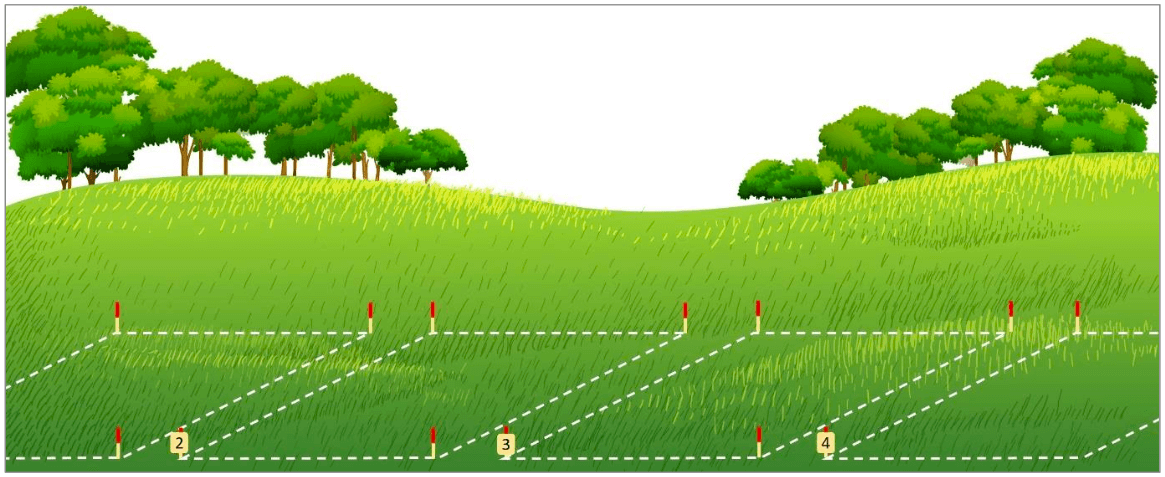
The location of the targets placed in each box should be recorded using the most accurate system available, preferably a Differential Global Positioning System (DGPS). In addition, the distance of the target should be precisely measured using an X and Y chart, measuring from the picket (or another marker) that shows the box number, located preferable at the bottom left picket.

Each target has two referral distances – X and Y. In case of MDD/TSD testing or in case the box is made for blind testing or accreditation, there should be no placards placed to indicate the target location. When setting target locations, it is recommended to use 50 cm integers.
The corridors between boxes should preferably be three meters wide, and should not be less than two meters wide, to allow ADS handlers to place their equipment and turn around without stepping into the boxes.
In many cases, the testing site is situated adjacent to the training site. Therefore, the separation between the different sectors of the area containing EO should be planned in advance, to assure that:
- There are a sufficient number of testing boxes for internal and external accreditation;
- There is enough space between the boxes to allow free movement of ADS units without entering the boxes;
- There is a clear separation between the external accreditation sector and the other sectors, and that the area contains signs that entrance is forbidden;
- The ADS units can establish their resting area and have short access to boxes, without stepping into other boxes or passing through ADS units working in the boxes; and
- There is sufficient space for the ADS units to warm up and prepare for testing.
If the site serves several testing scenarios, it is recommended to divide it into sectors, and make it clear which scenario is applied in each sector. When the boxes are numbered and marked, it is recommended to add a letter to the box number, symbolising its sector. For example, Figure 3 shows a separation between sectors A, B and C. This kind of separation helps to manage the testing procedures. In this example, the ADS organisation has designated A boxes for training, B boxes for blind, double blind internal testing, and C boxes for accreditation. In this way, the ADS organisation can know that box C- 12, for example, belongs to the accreditation sector, boxes that start with an A are for training, and boxes named with a B belong to the internal testing sector.
Testing sites should be periodically maintained, assuring that all target items and markings are in place. Target item verification procedure should be conducted every six months, unless specified otherwise by the relevant authority.
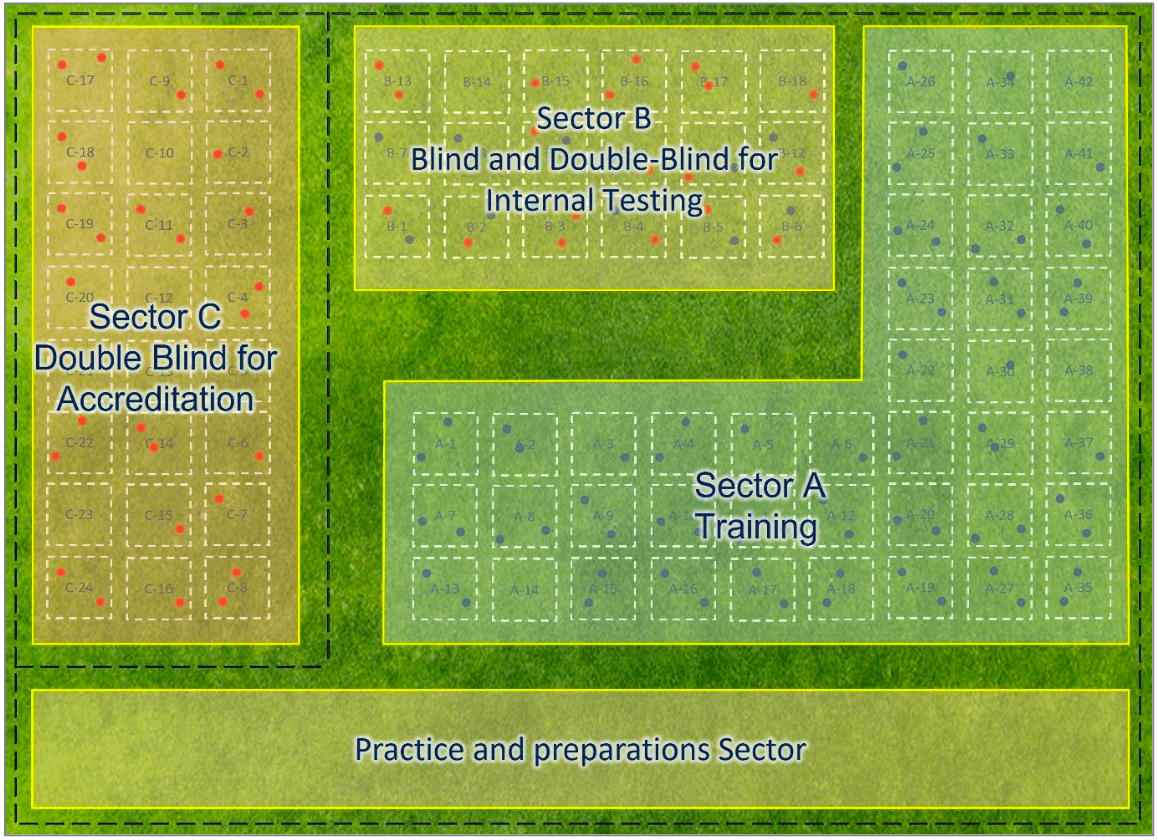
With the exception of TSD (please refer to Section 8.2), the vegetation in the testing site should be cut during periodic maintenance. Otherwise, overgrown vegetation can create challenges for manual hand- held strimmers. If such a site will eventually require a mechanical preparation it can cause unnecessary ground disturbance and make the site unserviceable.
If the vegetation in the testing site is cut, a minimum one week of resting period should be applied before testing is conducted. Other maintenance, such as removal of rubbish, fixing of fences and verifying targets should be done in such a way to not disturb the site, or to cause as minimal disturbance as possible, to not affect the intended purpose of the site.
Placement of targets should be made according to the following principles:
- The decision on target locations should be made on a planning map, to assure that there are a sufficient number of targets available, to set their depth and location;
- Items should be safe to move and handle, but should be handled with care, following the safety procedures related to their explosive content. Items should be washed and dried in the shade prior to planting. It is important to assure that any other materials used during the process do not leave any additional substance in the ground;
- The location of each test item within a testing site should differ from one box to another, avoiding any repeated patterns. The minimum distance between any two test items within the same box should be at least three meters. Since correct indication criteria allows the ADS to indicate within 1.25 meters from the target, two targets that are close to each other might create an uncertainty regarding the target that the ADS is indicating on. Exceptions can be made only in case of a specific aim to test ADS in a highly contaminated environment, if the ADS organisation has confirmed that it has the capability of preparing the ADS for such a scenario;
- In case of placing items close to the box boundaries, the items should not be placed closer than 50 cm to the boundary. If the corridor width is less than three meters wide, the items should not be placed closer than one meter from the boundary;
- Test items should be buried at different depths as encountered under operational conditions, as indicated by evidence from operational monitoring and/or information management systems and in accordance with required maximum clearance depth specified in the National Mine Action Standards (NMAS) / National Technical Standards and Guidelines (NTSG);
- When planning the locations of the test items in boxes, the minimum distance between items in two different boxes should be six meters. This to ensure that the animal does not pull towards a target situated in a neighbouring box;
- Disposable gloves (preferably nitrile gloves or similar) should be worn at all times when handling test items. New gloves should be used for each new test item to prevent cross contamination;
- All test items, tools, accessories and recognition pieces should be decontaminated prior to their use in a testing site, using available and approved methods;
- When preparing a pit in which to place an item, this should be done in a manner that preserves the soil layers so that the only ‘scarring’ of the soil is on the boundaries of the pit;
- After placing an item in the pit, its depth should be measured and the pit should be carefully covered, leaving the surface as natural as possible. Items should be placed directly into the pit, from their container, without placing them on the ground inside the box; and
- When low or zero metal content test items are used, the test site management should ensure that recognition pieces are placed to allow confirmation of the location of test items with metal detectors, without the need to disturb the ground. Recognition pieces should be placed in a way to allow and facilitate accurate positioning of the centre of a test item. The recognition pieces should be made of stainless steel, not exceed 15g and placed under the test item.
The X, Y location of all test items in a box, panel or search area should be recorded using a measuring tape, with an accuracy of +/-5 cm. In addition to the manual measurements of the X and Y axis the location may also be recorded using DGPS with a sub-meter level of accuracy. The depth (Z) should be recorded using a measuring tape or a ruler with an accuracy of +/-1 cm from the top of the mine. Both the location and the depth should appear on the general map of the testing site.
The required soak time depends on the precipitation, levels of moisture in the soil and ground/air temperatures, which influences natural transportation of the target odour from the test item to the surface. An ADS test site should have a minimum soak time of 90 days before use (although 180 days is recommended if practicable), in order to permit:
- The target odour to migrate to the soil surface, contaminate the topsoil, and start to evaporate into the air; and
- Any ground disturbance resulting from the burial of the test items to diminish.
In areas with little or no rain, the testing site should be watered several times during the soak period. In sites with cold winters, the test items should be allowed to rest in the ground over the winter. The same soak time is required for all test items, whether buried, partially buried or fully exposed. Test item should not be moved or disturbed during the soak period.
8. Testing sites of different ADS units
The size of boxes should be set according to the operational use of ADS units. While the set-up guidelines and the preparation principles are similar for all ADS, different types of ADS require different box sizes and considerations, mainly due to the differences in their operational deployment methods. Standard MDD boxes are 10x10 meters, MDR boxes are 5x20 or 10x20 meters, and TSD boxes are normally 25-meters long and can be 10 to 50 meters wide.
8.1 Mine detection dogs (long and short leash)
Short and long leash MDDs normally work in patterns of maximum 10-meters, therefore the traditional boxing systems of 10x10 meters should be applied. In case the box length is shorter than 10 meters, the box boundaries can be specifically reduced for the test purposes.
8.2 Technical survey dogs
TSD search pattern in testing is similar to long leash MDD. The main differences are the length of the search and the vegetation in the box. Normally, the TSD will be deployed for 25-30 meters and the testing box should be made accordingly. When building new TSD testing sites and where there is a sufficient space available, the boxes should be built in a natural area, without preliminary vegetation. cutting.
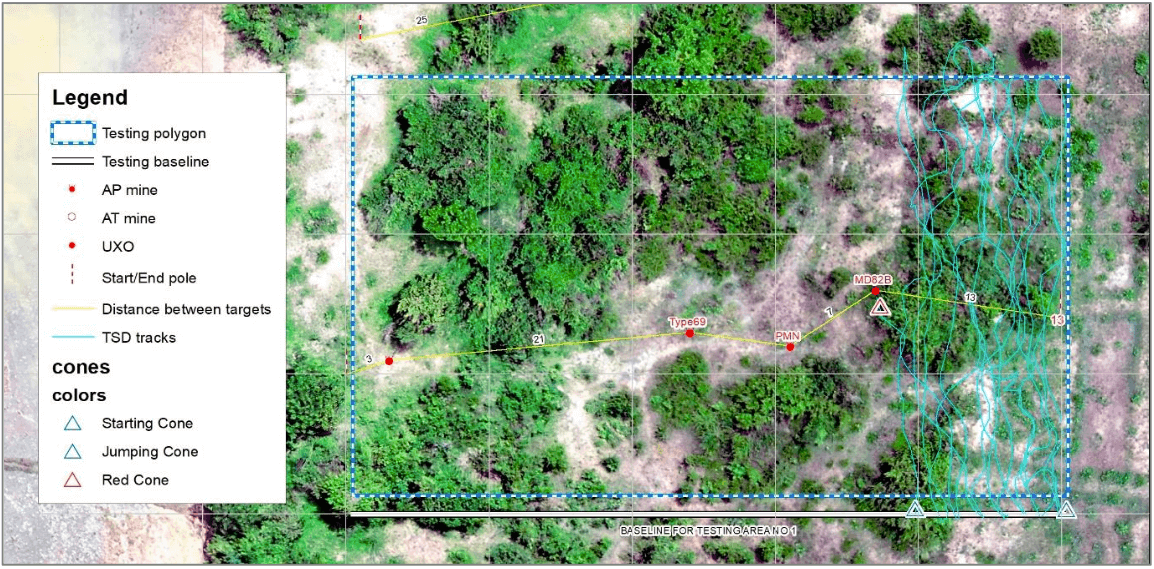
However, if there is no space to build new TSD boxes but there is an existing testing facility with 10x10 meter boxes, it is possible to combine two 10x10 meter boxes into one, including the 2–3-meter corridor and let the site rest and allowing the vegetation to grow to its natural condition. The disadvantage of such a setup is that the ADS handler is only able to choose two search directions and not four, as in 10x10 meter boxes.
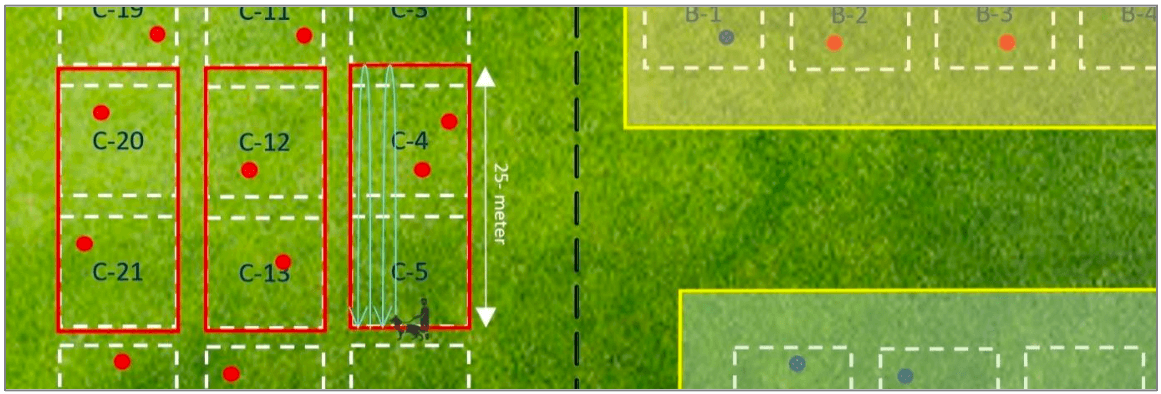
8.3 Mine detection rats
MDR are deployed in long boxes of 5-10 meters wide, depending on the width of the vegetation cutting method. Testing boxes should be set accordingly. A typical MDR testing should include 5x20 meter and 10x20 meter boxes. The main consideration that should be considered is the test schedule, since MDR are deployed in rotation and cannot complete a 400 m2 search all at once.
If there is only one testing manager, four MDR units can complete 200 m2 search in the first day and additional 200 m2 on the second day. In operations, MDR are not withdrawn from the box following an indication, therefore the testing should be made accordingly.
MDR operational teams normally have 10-12 rats each. Therefore, when testing MDRs, should assign more than one testing manager, to be able to test as many MDRs as possible within a single day.
9. Management of test records
The testing site should be accurately mapped, and its targets, boundaries and different markings should be recorded. The testing site file should include the map of the general area setup file and each one of the individual box records.
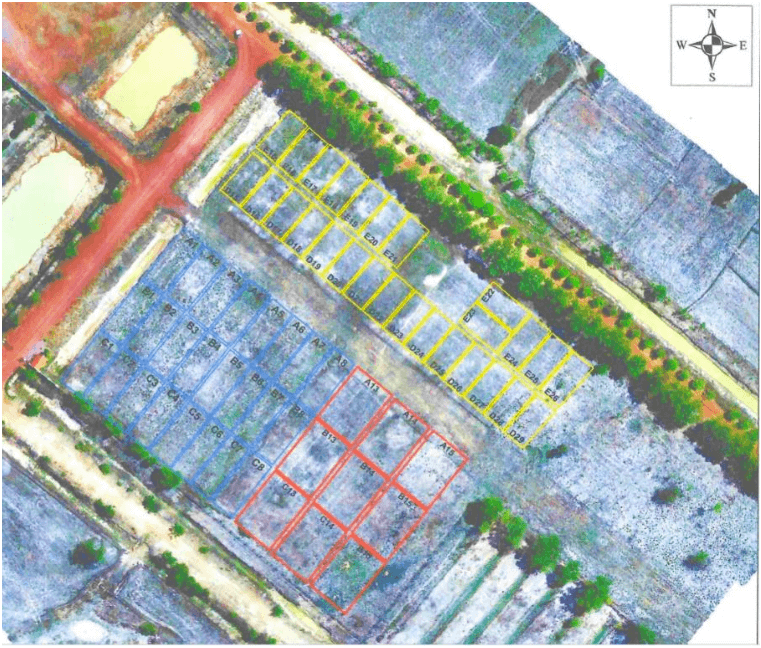
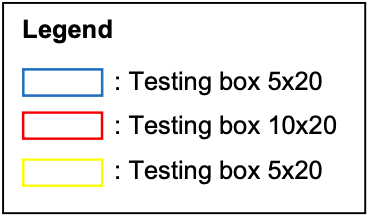

Throughout the test, the testing manager should have the testing site file in her/his possession.
Individual box records should contain the box dimensions, location of targets, their type and depth. The grid parameters should be set in advance and a common language should be established. Figure 7 shows an example of an MDR testing individual box record. The box is 5x20 meters and it contains two targets.
The testing manager should make copies of the individual box record files and use them as a draft for recording the ADS behaviour and indications.
Throughout the test, the testing manager should observe the animal search and make notes on top of the sketch. This becomes very relevant with MDD testing, when the ADS handler requests to change direction, wants to take a break or asks to pause the test for any reason.
The individual records of the testing should be confidential and can only be shared with authorised staff members. If there is a doubt that the testing records have been compromised, the organisation in charge of the testing site should change the box structure, while targets remain in the same place. This will require additional planning, preferable using ArcMap. After the new box structure is defined, the corner pickets and the placards will be moved and placed in their new locations.
In sites where ADS units are tested several times per year, testing box numbers should be switched, to change the location of the box pole, or both from time to time.
10. Special testing occasions
The ADS chapters in the IMAS provide the guidelines for the use of ADS on items buried in the ground. However, there might be additional operational scenarios that will require different ways of testing. Such scenarios can include:
- Testing ADS on freshly buried items;
- Testing ADS on EO in urban areas; and
- Testing ADS on EO detection in an environment that has a typical or strong background odour.
Prior to the setup of testing sites in special occasions, the interested organisation, agency or NMAA should seek for expert advice from ADS organisations and get scientific support, if available. One of the main questions that should be asked is whether the ADS organisation has the ability to build sufficient training sites to prepare the ADS for a specific test.
This type of testing needs to be planned in advance, after receiving all the available support and through a continuous dialogue with the ADS organisation. Another important question to be asked by interested parties is whether the new scenario can be added to the existing detection scope of buried EO, or the difference is so big that the ADS will only be able to focus on the special scenario targets.
Annex A (Normative) References
The following normative documents contain provisions of IMAS that are applicable to the understanding and effective execution of this T&EP. For dated references, subsequent amendments to, or revisions of, any of these publications do not apply. However, parties to agreements based on this part of the standard are encouraged to investigate the possibility of applying the most recent editions of the normative documents indicated below. For undated references, the latest edition of the normative document referred to applies. Members of ISO and IEC maintain registers of currently valid ISO or EN:
-
IMAS 04.10 Glossary of mine action terms, definitions and abbreviations;
-
IMAS 07.12 Quality Management in Mine Action;
-
IMAS 07.31 Accreditation and operational testing of Animal Detection Systems and handlers;
-
IMAS 07.40 Monitoring of mine action organisations.
Other IMAS chapters which are supportive of the application of this T&EP are:
-
IMAS 07.11 Land Release;
-
IMAS 07.30 Accreditation of mine action organisations;
-
IMAS 08.20 Technical Survey;
-
IMAS 09.10 Clearance requirements;
-
IMAS 09.40 Animal Detection Systems – Principles, Requirements and Guidelines;
-
IMAS 09.41 Operational procedures for Animal Detection Systems;
-
IMAS 09.44 Guide to occupational health and general dog care.
The latest version/edition of these references should be used. GICHD holds copies of all references used in this T&EP. A register of the latest version/edition of the IMAS standards, guides and references is maintained by GICHD, and can be read on the IMAS website (www.mineactionstandards.org).
National employers, mine action authorities, and other interested bodies and organisations should obtain copies before commencing mine action programmes.
Annex B (Informative) References
The following informative references provide useful terminology and guidance for detection dog training and certification:
-
ANSI/ASB Standard 088, 1st Ed. 2020, General Guidelines for Training, Certification, and Documentation of Canine Detection Disciplines
-
Centre for the Protection of National Infrastructure: Canine Detection Guidance Notes;(website)
-
International Forensic Research Institute: SWGDOG Approved Guidelines (website).
Amendment record
Management of T&EPs amendments
T&EPs are subject to review on an ‘as required’ basis. As amendments are made to this T&EP they will be given a number, and the date and general details of the amendment shown in the table below. The amendment will also be shown on the cover page of the T&EP by the inclusion under the version date of the phrase ‘incorporating amendment number(s) 1 etc.’
As reviews of T&EP are made, new versions may be issued. Amendments up to the date of the new version will be incorporated into the new version and the amendment record table cleared. Recording of amendments will then start again until a further version is produced. The most recently amended T&EP will be the versions that are posted on the IMAS website at www.mineactionstandards.org.
| Number | Date | Amendment |
|---|---|---|
